| Lista Light |  |
Marquesas to Tuamotu
Before leaving the Marquesas, we got a weather forecast (for once!) both from Richard via his SSB radio, and the internet, and both showed favourable (Easterly to South-Easterly) strongish wind (15-20 knots) for the 4-5 days of our passage, which was good to know and exactly what gets Lista Light going along well. We weighed anchor early on the 17th June and headed out of Tahiohae Bay, immediately feeling the wind as we cleared the land and raising the mainsail, staysail, mizzen and medium jib for a broad reach which gave us a comfortable 6-7 knots. The wind was fairly constant and the sailing good until around dawn the next morning, when it eased off to the point where the engine was required for a while, but a few hours later we were off again at 5-6 knots, which is where it stayed for 48 hours.
It was slightly more effort with just four of us, our overnight watches being 2 people on for 4 hours, off for 4 hours, but it wasn't uncomfortable with some extra sleep top-up during the day as we went. We also changed our normal one hour on, three off rotating day steering rota to a two hour shift, which gave us six hours off in the day and a bit more time to get things done between watches.
Following the recent hair chop theme, Merryn got her scissors out again and attacked Jay, and Rob busied himself with his grooming, in keeping with his posh new look.
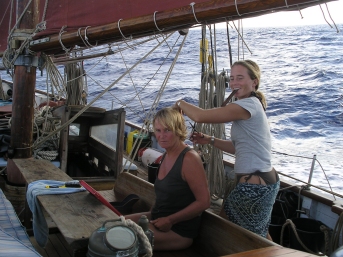
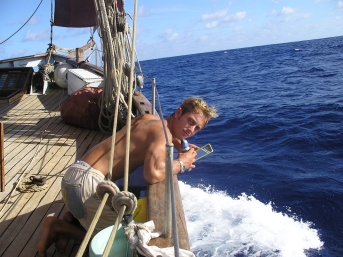
The weather stayed clear and sunny, and the wind kept on blowing - perfect sailing weather, but by the 20th we realised that we were making time too well, and that we would arrive early for the correct tide state for entry into the lagoon through the pass. The wind freshened a little and we ended up running under double reefed mainsail alone, trying to slow our progress! The fresher wind also carried squalls and some heavy rain too, and we started to think that the sea would be too big to attempt the passage into the lagoon at all, and changed course for Ahe, where the pass is more protected and the sea would hopefully be calmer by the time we arrived there. We also had one minor disruption of another steering cable snapping whilst Merryn was on night watch, fortunately Rob had crafted a slightly better emergency tiller than the one we had previously used whilst crossing the Pacific as the seas were a lot bigger. The decision was made to fix it there and then so that we could make it to the atoll at the right tide window, and because steering 35 tons worth of boat isn't that easy with a tiller, so Rob hung over the side harnessed on whilst Jay fed the new cable through and Mike and Merryn took it in turns to steer. Merryn commented that it would not be the type of task you would like to undertake with a hernia (as one of our friends had done previously on their boat) but as consolation was very excited about the six pack that she would be parading the next day - unfortunately it never transpired and all there was to show was a few bruises!
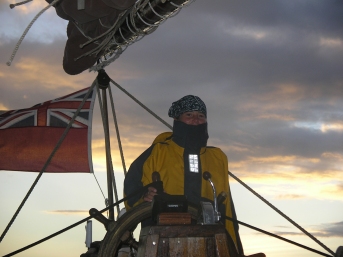
Apart from the steering cable mishap, all in all it was another good (and lucky) sail for Lista Light; boats who had left a week before hadn't had a breath of wind, and boats who left the week before that had 50mph gales in the Tuamotus!
The Tuamotus consist of about 77 atolls and islands stretching over 1000 miles, an atoll being a low lying fringing coral reef built on the remains of a volcano with a salt water lagoon in the middle; the Tuamotu atols range in size from a few miles across to over 50 miles long. The low lying landscape was a sharp contrast to the steep rocky terrain of the Marquesas; in time, as the Marquesan mountains erode and the coral reef around them grows, the relatively young Marquesas will end up being atols similar to the Tuamotus.
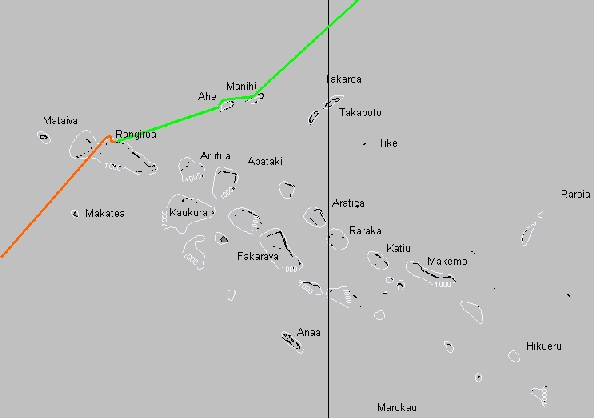
There are usually one or more 'passes' in this coral reef that enables boats to enter into the lagoon where it is more sheltered from the ocean waves and there is some amazing coral. The main industry of these atolls is the farming of black pearls from odd little sheds on stilts, with trails of rope holding pearls criss-crossing the lagoon.
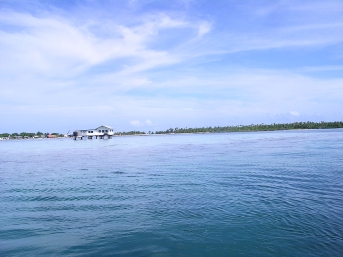
There are very strong currents and rips that flow out of the passes in the lagoons depending on both the state of the tide and how rough the seas are outside the lagoon - if the sea is rough the waves spill over the reef in some places filling the lagoon and the easiest way out for the extra water is to rush through the pass. Despite our running repairs and deviations due to the weather, we still managed to arrive slightly before what we had worked out to be the correct time of day to enter the pass, although unfortunately it was also spring tides, which means that the outflow from the lagoon is at its strongest and the seas were also relatively large due to constant 20 knots of wind for the previous 3 or 4 days that we had enjoyed. This meant for a pretty hairy entry into the lagoon - of course this is the highlight of the day for the locals who spectate from the edge of the pass as the novice yachties get swirled around and fight the outflow of the lagoon! We had our trusty engine up at full blast as we inched forward against 6 knots of outflow at the narrowest point, and once through the pass, which is about 500m long, we had to quickly reduce speed to prevent ourselves piling into one of the numerous coral heads.
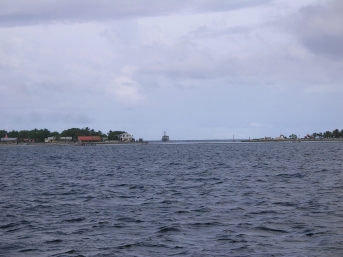
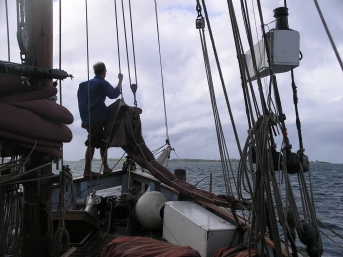
The little bits of 'land' around the outside of the lagoon are called Motu's and these are joined by patches of awash coral, together making the outside of the atol.
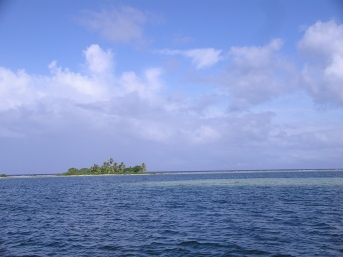
We carried on around to the south side of the lagoon, and anchored in calm lagoon water behind a large motu for protection, which was a lovely change from the bumpy sea of the last few days.
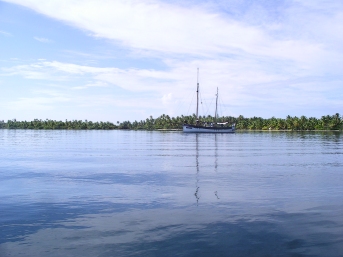
After a day or two of complete relaxation and solitude, Merryn and Rob ventured to town to have a look around. Although the town itself wasn't anything to write home about, we were very pleased to find a lettuce (the first one for ages!!) in the shop, and we enjoyed watching the local boats zooming through the pass with the ebb current. Shopping in remote Pacific islands isn't like going to Tesco's - there is a severe lack of anything remotely fresh or vegetable or salad-like, and what there is has been frozen, costs the earth and goes off instantly!
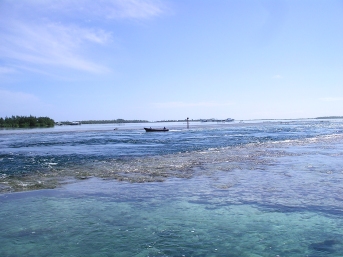
There was a large smart hotel on one side of the lagoon, where our guide book said bikes could be hired for a 6km ride along a track; however when we asked at the hotel we were informed that the bikes were now for guests only, so that put paid to that idea!
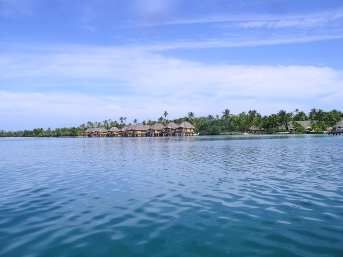
Several days later of doing not much at all, and we were ready to depart for our next stop, Ahe. After much tidal calculation we decided to leave at 8am, but unfortunately the anchor chain had got badly stuck around some coral heads and despite lots of manoeuvring in a vain attempt to unwind ourselves, Rob ended up getting the scuba gear on and directing movement from 20m below! All this shenanigans made us over an hour late for slack water at the pass, but there was an outflow which actually made the exit from the pass easier, carrying us along smoothly out to sea.
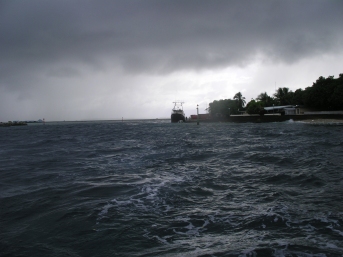
The day's sail was rather showery, windless and gloomy, but we made it under engine only to Ahe by 3pm and enjoyed a smooth entry with 1 knot of tidal flow, and carried on down through the lagoon to the anchorage near the village of Taukapara.
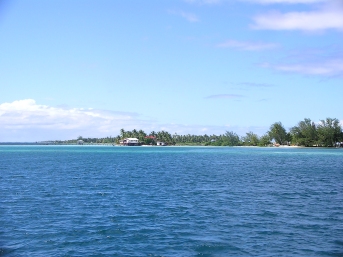
There were only three other boats anchored there, which was surprising considering it's reputation as a popular stop by yachties, and after a walk around town and a snorkel near the boat, we decided to push on the next day to the relative civilisation of Rangiroa, the quiet anchorage in Ahe being pretty similar to Manihi. Meanwhile, Rob took advantage of the quiet water of the lagoon to do a quick job at the top of the topmast whilst he wasn't flung around like a pendulum.
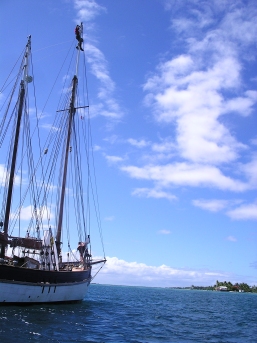
Weighing anchor late that afternoon and raising staysail and main for a sail up the lagoon, we exited the pass against 3 knots of inflow, the sails helping to steady the boat and give a little extra push against the current. The overnight sail of 80 miles to Rangiroa was largely uneventful, the light following wind requiring a night of engine assistance to make enough headway to arrive at Rangiroa's Tiputa pass by 8am, where we had 3 knots of inflow current driving us comfortably through the pass. We anchored off the Kia Ora hotel in beautiful turquoise water, a popular anchorage with some fiveteen other boats already there.
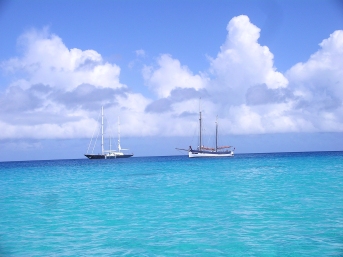
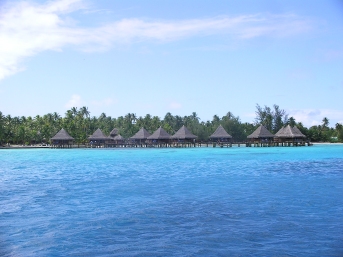
The main inhabited part of Rangiroa consists of two villages at either end of the 6km spit of land between the two main passes into the lagoon. Pensions, pearl shops and snack bars and restaurants abound along the road between the two villages, which we negotiated with bikes hired for the day, which was a bit of a shock to the muscles! We had a well earned sundowner at the Kia Ora hotel, with a beautiful view of the sunset over the lagoon, and some excellent food at a local restaurant.
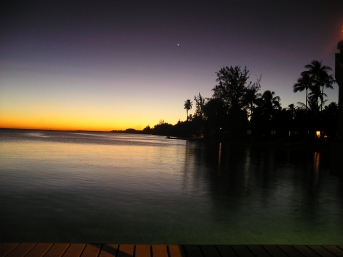
After a slow day relaxing and getting some laundry done, Mike and Rob braved the current in the pass the next morning and did a drift snorkel through from the reef outside into the lagoon, during which Rob was happy to finally see his first shark at close quarters - it was only a five-foot reef shark but Rob was happy anyway!
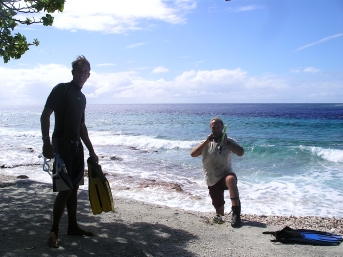
Back to previous section - Galapagos Islands to Marquesas
Forward to next section - Tuamotu to Society Islands
This page hit Count : 208446
This is the Lista Light Website, for the travels of the sailing boat Lista Light
Click here for text-version of site